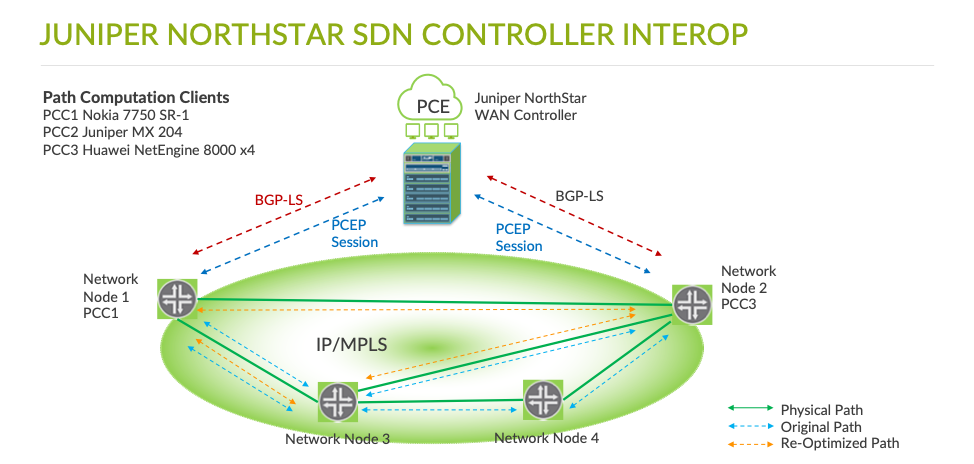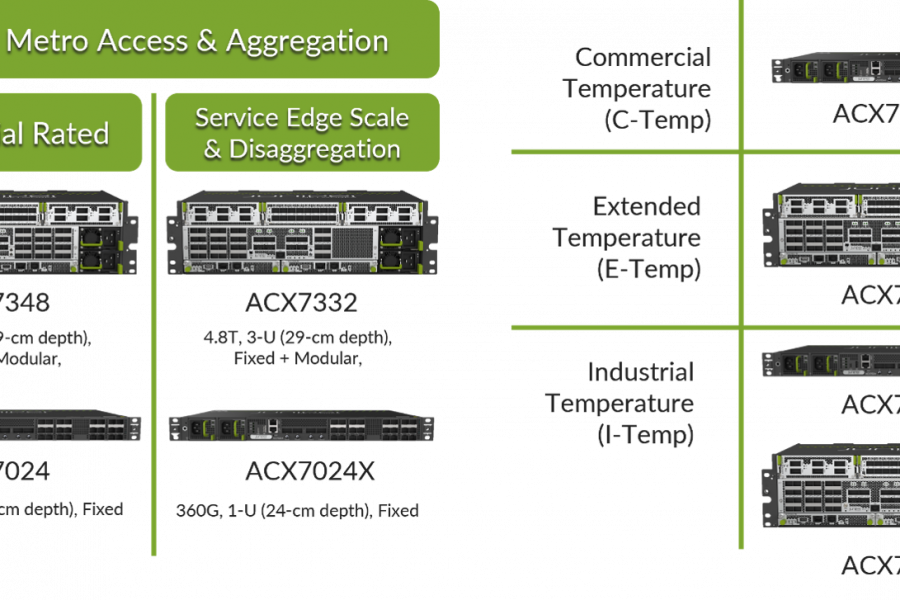This is the fourth in a series of seven blogs that focus on several areas of interoperability testing including Segment Routing (SR), EVPN, SDN Controllers, Network Automation and Timing & Synchronization. The test report is publicly available and can be found here. See part three on segment routing here.
Juniper NorthStar SDN Controller Solution
A wide area network (WAN) software-defined networking (SDN) controller automates the creation of traffic-engineering paths across the network to ensure a more efficient network operating model with granular visibility into and control over IP/MPLS flows in large service provider and enterprise networks. As a result, WAN SDN controllers are able to map customer and application SLA requirements to network paths, monitor the paths for performance against the SLAs and adjust the paths as needed to ensure the SLAs are maintained. Through the power of Junos OS, optimization algorithms and transport abstraction, optimizes network architectures. A powerful and flexible toolset, NorthStar gathers Junos IP/MPLS and analytics to unleash new levels of control and visibility that help avoid costly overprovisioning.
As the industry’s first WAN SDN controller for traffic optimization, NorthStar provides granular visibility into, and control over, IP/MPLS and SR flows in large service provider and enterprise networks. NorthStar Planner helps users create explicit routing paths dynamically using global views based on user-defined constraints.
Path Computation Element (PCE) Interoperability Tests
A Path Computation Element (PCE) computes network paths based on its knowledge of the network and path attributed provided by the end-user, a network operator or other backend system while a Path Computation Client (PCC) is a client application that requests for a path computation to be performed by a PCE. NorthStar provides a centralized PCE, which allows it to have visibility over the entire network domain by collecting streaming telemetry and BGP-LS data from all of the nodes in the network. The PCE function of the Juniper NorthStar SDN WAN controller was tested with other vendors’ PCC devices at EANTC 2020 and the report is available here. The testbed topology shows the Juniper NorthStar SDN WAN controller as PCE and other vendors’ routers as PCC devices. Vendors included:
- Nokia 7750 SR-1
- Huawei NetEngine 8000 X4
Additional testing occurred with Juniper working as the PCC device with the PCE controller from these vendors:
- Nokia NSP Server
- Lumina SDN controller

PCE-Initiated Paths in a Stateful PCE Model
The Juniper NorthStar Controller allows Network Operations (NetOps) teams to manage complicated tasks, including bulk transport tunnel provisioning, creating disjoint primary and backup paths or automatic path rerouting based on network events or maintenance tasks. Path traffic engineering is possible for RSVP or segment routing signaled paths simultaneously, offering agility and flexibility for NetOps teams. Path traffic engineering can be done globally at scale with a real-time view of the network using different constraints like the amount of traffic measured on network interfaces or existing LSP paths, path delay or path cost.
In order to build the global view of the network, the NorthStar Controller executes a TCP-based PCEP protocol with the PCC, as defined in IETF RFC5440, extended in IETF RFC8231 (Stateful PCE Support), IETF RFC8281 (PCE Initiated LSP/Path Support) and IETF RFC8664 (Segment Routing LSP/Path Support).
In the case of a link failure scenario between two nodes, the backup path needs to be created dynamically by the PCE. In this test, we verified the LSP setup, state synchronization, update and deletion of PCE-initiated LSP without needing any local configuration of PCC. The test topology included one centralized PCE and two PE nodes acted as PCC. Additionally, two transport nodes are also used in the test to re-optimize the LSP.
Additional tests were performed with RSVP LSP tunnel provisioning. This is an additional flexibility for service providers as segment routing and RSVP LSP tunnels can coexist and be managed by the NorthStar SDN WAN Controller simultaneously.
During EANTC testing, the following role-based configuration was used:
- PCE Juniper NorthStar SDN WAN Controller
- PCC1 Nokia 7750 SR-1 router
- PCC2 Juniper MX204 router
- PCC3 Huawei NetEngine 8000 X4 router
The test began by setting up an LSP path from PCC1 to PCC3 directly and vice versa; subsequently verified the path creation and traffic forwarding via tunnel establishment. Next, we changed the network cost parameters (link TE cost), allowing the controller to re-optimize traffic path. In this test, we used segment routing as the technology to set up LSP tunnels. In addition, the Juniper NorthStar SDN WAN Controller can provision LSP tunnel paths with RSVP protocol signaling.
- The Juniper NorthStar Controller successfully created two paths between PCC1 and PCC3. The paths were active and segment routing SID information was displayed in the Record Route table. In addition, traffic testers from Spirent were connected to the topology and a service example was created between PCC1 & PCC3. This service was a L3VPN between PCC1 and PCC3 as shown in Figure 2.

- Following the LSP tunnel creation, path optimization was performed by the PCE to show the optimization capabilities of NorthStar. In order to execute path optimization, the traffic engineering link cost was changed first on PCC1, then on PCC3 on the link that was connecting PCC1 & PCC3 directly as shown in Figure 3. The TE link cost was set up to 2000 on PCC1 (Nokia SR 7750 SR-1-2). Following a successful path optimization by NorthStar, the new path of the LSP tunnel is now routed via PCC2 (Juniper MX204-4).

- Next, LSP optimization was performed for the opposite direction, i.e. the LSP tunnel from PCC3 to PCC1 with a change in the TE link cost from PCC3 to a value of 2000 as shown in Figure 4. Please note that all TE link cost changes are automatically displayed on the NorthStar GUI as a result of real-time synchronization for the traffic engineering database of the routers and the PCE.

- Once the TE link cost is changed, we can see that the LSP tunnel is being rerouted via PCC2 (Juniper MX204-4 router) to accommodate new network parameters. This is displayed in Figure 5

- This an example of network path optimization completed on one link. NorthStar performs this globally on the entire network based on different conditions like path TE cost, link bandwidth optimization or path delay. It is up to operator to choose which method of optimization for the given network.
- The LSP tunnels deletion process was demonstrated on both PCC1 and PCC3 by the NorthStar operator panel. The process is visible in Figure 6 , Figure 7 and Figure 8.

- Selected LSP tunnel is deleted from PCC1 (Nokia 7750 SR-1-2).

- Only the reverse LSP tunnel from originating from PCC3 (Huawei NetEngine 8000 X4) remains.

- Selected tunnel is deleted from PCC3 (Huawei NetEngine 8000 X4).

- No LSP tunnels are present on both test devices PCC1 & PCC2 as shown in Figure 9.
Juniper Technology Fuels the ‘Cloud + 5G + AI’ Era Transformation
We are providing a new generation of networking solutions to help our customers succeed in the ‘Cloud + 5G + AI’ era. Among them is the NorthStar SDN WAN Controller, which is an essential part of the modern service provider’s NetOps toolbox. Testing at EANTC 2020 has proven that NorthStar offers the following benefits in a multivendor environment with a rich feature set providing flexible and agile services as dynamic network conditions unfold:
- Provides specific ordering and synchronization of paths signaled across routed network elements and allows a global view of network state for monitoring, management and proactive planning.
- Features a predictable, deterministic network state within margin of demand forecast error. In addition to a minimized distributed state, it provides increased efficiency of existing network elements via offloading of control plane processing.
- Provides a foundation for additional centralized network infrastructure services—API for the network with NetConf/Yang and RESTCONF. Provides operational simplicity through enabling of an SDN control point across disparate elements across the network.
In our next interoperability blog, we will address the NetConf/Yang interoperability with other vendors.
Explore automated next-generation data center operations and join interactive breakout sessions at our Juniper Virtual Summit on June 10 (US/EMEA) and June 11 (APAC).


